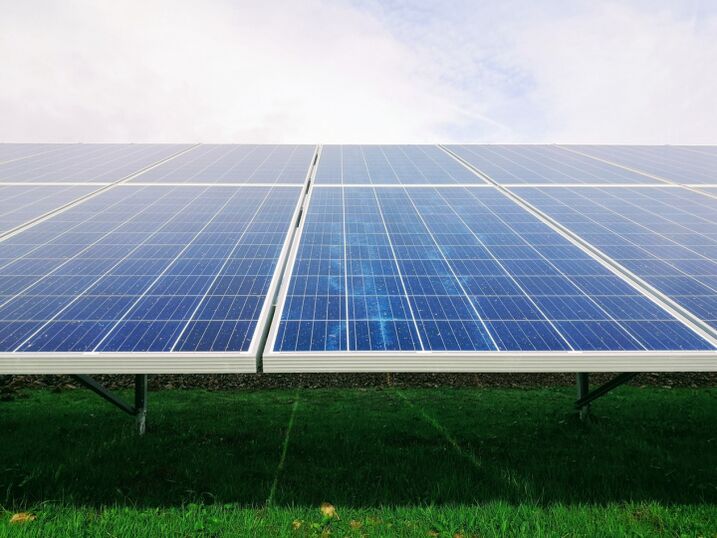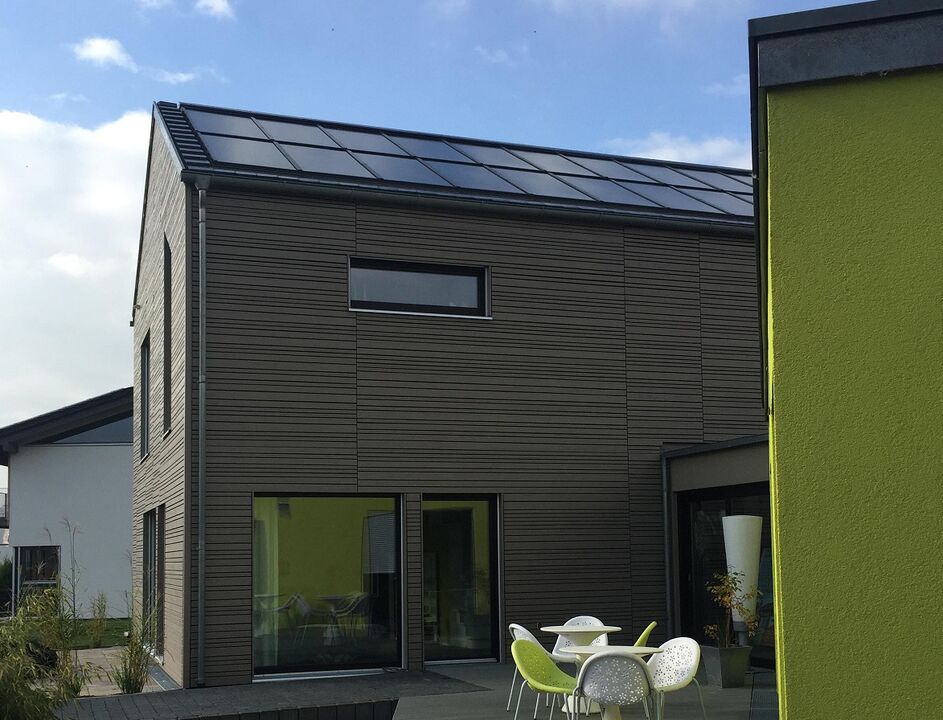
Unlike the high-performance and expensive heating system that is installed in conventional houses, the energy-efficient house does not burn fuel and does not convert grid electricity into heat (except in cases of critical temperature drops). Thanks to well-thought-out thermal insulation, ventilation with recovery and the optimal location of the building, such a house persistently retains the so-called passive heat. And anything can be used as a source of this passive energy:
- direct sunlight penetrates through the windows;
- heat produced by household appliances and even by the population and pets;
- and, of course, devices whose main function is to supply the house with solar energy - solar cells (batteries), which will be discussed.
Solar panels fit harmoniously into a passive house, as they fully comply with the main principle of the construction - the use of renewable energy from the environment.

The principle of operation of solar panels and their interaction with other home systems
- The operation of solar cells is based on the conversion of thermal radiation acting on silicon wafers into electrical current;
- Solar panels enable the use of solar energy to operate household appliances, ventilation systems and (partially) heating;
- If the output of the solar panels exceeds household needs, the excess energy can be used in systems for storing and converting electricity.
- If the power demand exceeds the capacity of the panels, the missing part can be obtained from the grid (grid solar station option) or from a liquid fuel generator (autonomous solar station).
Types of solar modules
Photovoltaic systems are classified according to the criteria of the materials and constructions used. The solar panels are:
- In the form of silicon panels (the most common, the most powerful and the most expensive), efficiency - up to 22%; It is produced in three subtypes: monocrystalline (the most reliable), polycrystalline and amorphous; in the first two positions, pure silicon is used, in the third - silicon hydrogen, which is applied to the substrate;
- Film - made using cadmium telluride, copper indium selenide and polymers. The price is lower, but their performance is also lower (efficiency 5-14%), so in order to adapt the battery to the "appetite" of the home, it will be necessary to increase the area receiving radiation.
The consumer properties of solar panels are described by the following characteristics:
- Force.The larger the area of the solar panel, the higher its performance; In summer, approximately 1. 5 m2 of solar panels will be needed to produce 1 kWh of energy per day. The most effective performance is manifested when the rays fall perpendicularly on the surface of the battery, which cannot be ensured continuously, so changing the panel's performance during daylight hours is a natural process. In order to provide the required amount of energy in spring and autumn, about 30% must be added to this area;
- Efficiency(efficiency) of modern solar panels - on average about 15-17%;
- Battery life and power loss over time. Manufacturers usually guarantee the operation of solar panels for 25 years, and during this period they promise a power reduction of up to 20% of the original power (for some manufacturers, the lifespan varies between 10-25 years with a guarantee of a power reduction of up to 10%. Crystal modules are the most durable, their estimated lifetime is 30 years. The world's first solar cell has been operating for more than 60 years. The decline in the production of solar modules itself is primarily due to the gradual destruction of the sealing film and the clouding of the layer between the glass and the solar cells - due to moisture, ultraviolet radiation and temperature changes;
- Battery included, which ensures the night operation of the panel, complements the capabilities of the solar generator well. The battery usually lasts less than the solar module itself, on average 4-10 years;
- Availability of additional nodes– for example, a voltage stabilizer, battery charge controller, inverter (DC-AC 220 V converter for household use) makes the operation of the device and its integration into the "Smart Home" system more convenient;
- Battery cost– directly depends on your area: the more powerful the device, the more expensive it is. In addition, foreign-made panels are still cheaper than domestic ones, since solar panels are more popular there than here. But when comparing the prices of our and imported devices, you must first compare the operating efficiency of the solar panels with each other - here the domestic manufacturers achieve good efficiency indicators - up to 20%.
Selection and use of photovoltaic batteries
When choosing solar panels for a private house, they are primarily based on the tolerable load. In addition, the geometry of the house and the planning of preventive maintenance activities must be taken into account, which together require careful consideration of the following aspects:
- Daily energy consumption of devices designed for solar energy (room lighting, household electrical consumers, security and automation devices, etc. ). It should be taken into account that charging and discharging batteries also consume energy (about 20%), and additional equipment will also have losses (for example, in an inverter, on average - 15-20%);
- The relationship between the required dimensions of the work panels and the corresponding roof surfaces and its geometry;
- Cleaning the working surface of the batteries from dirt, snow and other factors affecting the operation of the photoconverters.
Important points in the operation of solar panels
- Avoid physical damage to the panel (scratches and damage to the integrity of the protective film can lead to shorting and/or corrosion of the contacts);
- In harsh climatic conditions, it is recommended to equip the solar stations with wind protection structures;
- Regular inspection, cleaning and maintenance are mandatory.
Cost and return on solar panels
In the central zone of our country, each kilowatt of solar energy produces the following amount of energy:
- in summer - 5 kWh/day (May-August);
- in spring and autumn - 3-4 kWh/day (March-April, September-October);
- in winter - 1 kWh/day.
When calculating the costs of an autonomous solar station, in addition to the cost of the power unit produced by the panels (about 60 rubles / 1 W), the cost of additional equipment should be taken into account: from fixings to wiring. batteries, protection devices and inverters (which is at least 5% of the total cost, but prices can vary significantly depending on the manufacturer and performance).
According to the experts' recommendation, the optimal costs of the year-round solar system can be achieved by using the "summer option plus backup electric generator" scheme. True, the generator will have to be switched on in spring and autumn, not to mention winter (solar panels were never designed tobe fully charged in the winter season).
When calculating the payback time of the solar installation, its performance is compared with the parameter taken as a base. In the case of a grid solar station, these are electricity tariffs, in the case of an autonomous solar system, this is the cost of the energy produced by the liquid-fueled electric generator. The payback estimate is based on a 1 kW solar panel producing approximately 1, 000 kWh of energy per year.
If we take the average price of 1 kWh of electricity as 5 rubles, then the payback period of the grid solar station is: 80, 000 rubles / 5 rubles * 1000 kWh = 16 years.
With a 30-year guarantee for the grid solar installation, the payback (at a tariff of 5 rubles/kWh) will take place within 16 years, and the electricity will be provided free of charge for the next 14 years.
As for an autonomous solar system, strictly speaking, the amount of energy it produces will be less than the designated 1000 kWh per year that it shares with the electric generator. But for rough calculations, this number does not need to be reduced - in order to approximately take into account the increase in specific fuel consumption, which occurs when the generator is partially (that is, periodically, not continuously) loaded. Then the payback period of the autonomous system (based on the cost of energy produced by the liquid fuel generator - 25 rubles / 1 kWh) looks like this: 150, 000 rubles / 25 rubles * 1000 kWh = 6 years.
In addition to the technical indicators, the efficiency of the solar cells that are part of the autonomous solar power plant is also confirmed by their payback period, which is 6 years.
Tariffs are not reduced
However, the installation examples related to solar energy suggest that the tariffs can be individually "frozen" and savings can be made by taking advantage of the features of the photovoltaic panels. They should only be purchased from branded, market-tested manufacturers so that their parameters can be calculated both in design and operation.
And it is best to deal with issues such as: even at the planning stage of the energy-efficient house:
- ensuring that the southern facade is not shaded;
- choosing the angle of inclination of the roof and the working surfaces of the panels;
- the correct orientation of the house to the cardinal points;
- preventing the shading of the working areas of the solar panels, blocking them with tree leaves, etc.

In this case, all parameters are optimally connected to each other, and the most efficient operation of the solar panels for a given structure will be ensured.


























